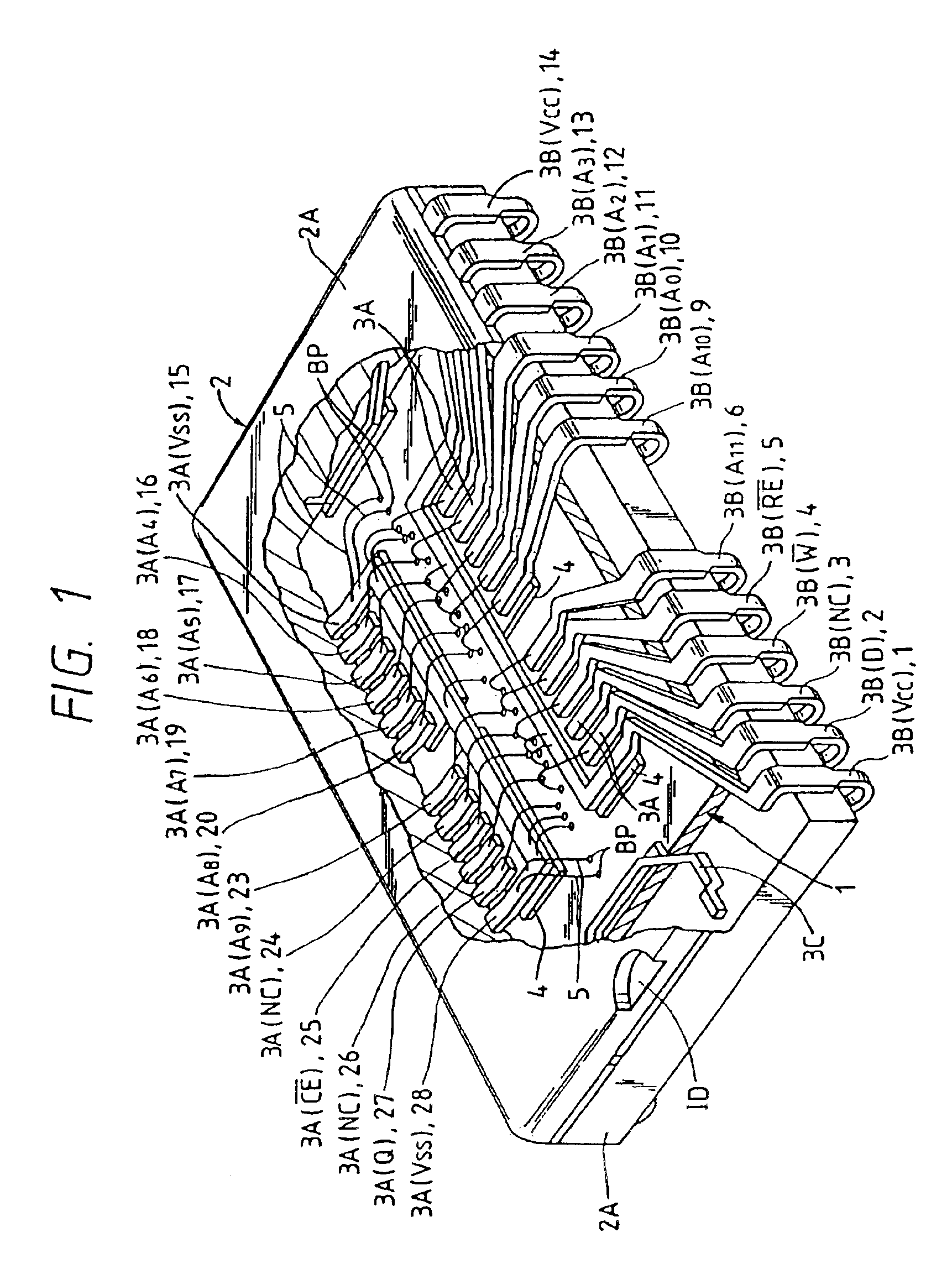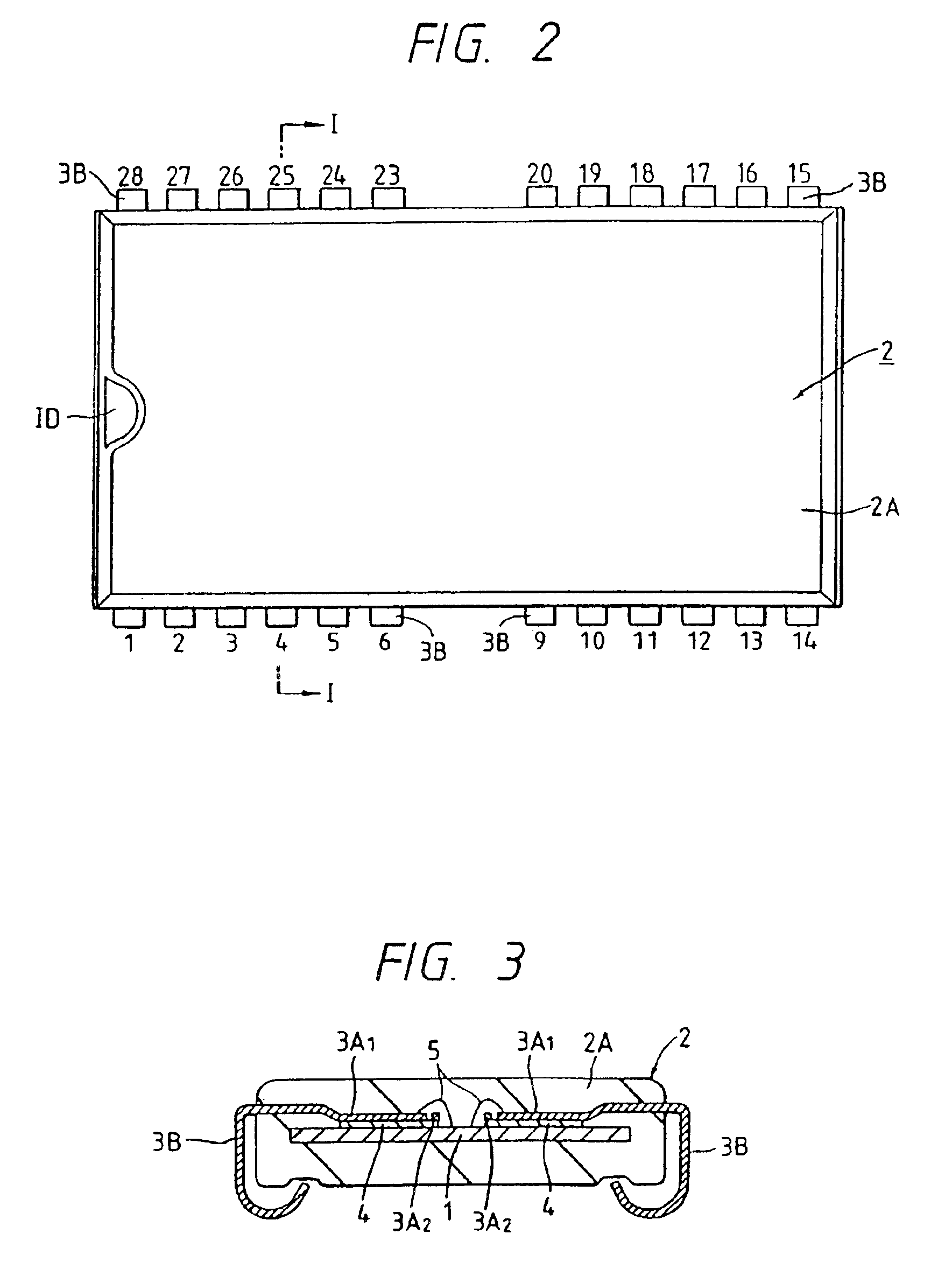Semiconductor device
a semiconductor device and semiconductor technology, applied in the direction of printed circuit assembling, printed circuit non-printed electric component association, printed circuit manufacturing, etc., can solve the problems of package cracking, weak semiconductor device, reliability drop, etc., and achieve the effect of efficiently cooling the individual semiconductor device and reducing the above-mentioned parasitic capacity
- Summary
- Abstract
- Description
- Claims
- Application Information
AI Technical Summary
Benefits of technology
Problems solved by technology
Method used
Image
Examples
embodiment i
(Embodiment I)
[0190]A resin-sealed type semiconductor device or sealing a DRAM according to the embodiment I of the present invention is shown in FIG. 1 (in partially sectional perspective view), in FIG. 2 (in top plan view) and in FIG. 3 (in section taken along line I—I of FIG. 2).
[0191]As shown in FIGS. 1, 2 and 3, a DRAM (i.e., a semiconductor chip) 1 is sealed with an SOJ (Small Out-line J-bend) type resin-sealed package 2. The DRAM 1 is made to have a large capacity of 16 (Mbits)×1 (bit) and a rectangular area of 16.48 (mm)×8.54 (mm). This DRAM 1 is sealed with the resin-sealed package 2 of 400 (mil).
[0192]The DRAM 1 has its principal surface arranged mainly with a memory cell array and a peripheral circuit. The memory cell array is arranged in a matrix form with a plurality of memory cells (or elements) for storing information of 1 (bit), as will be described in detail hereinafter. The peripheral circuit is comprised of a direct peripheral circuit and an indirect peripheral ci...
embodiment ii
(Embodiment II)
[0291]In the semiconductor integrated circuit device according to the Embodiment II of the present invention is constructed, as shown in FIG. 20, FIGS. 21A and 21B and FIGS. 22A and 22B, the insulating films 4 adhered to the principal surface of the semiconductor chip 1 of the foregoing Embodiment I are modified such that insulating films 4A are arranged all over or partially of those sides of the signal inner leads 3A1 and the common inner leads 3A2, which are located in the closest position to face the semiconductor chip 1.
[0292]More specifically, as shown in FIG. 20, the aforementioned insulating films 4A are placed in advance all over the most closest sides of the signal inner leads 3A1 and the common inner leads 3A2 facing the principal surface of the semiconductor chip 1 and are then fixedly adhered to the semiconductor chip 1, when assembled.
[0293]The lead frame 3 thus carrying the insulating films 4A is manufactured altogether with the signal inner leads 3A1 t...
embodiment iii
(Embodiment III)
[0306]In the semiconductor integrated circuit device according to the Embodiment III of the present invention, as shown in FIG. 23, the whole region of the principal surface of the semiconductor chip 1 except the bonding pads BP of the principal surface of the semiconductor chip 1 of the foregoing Embodiment I is coated with an alpha ray shielding polyimide film 8, and the principal surface of the semiconductor chip 1 further formed with insulating films 4D on its portions to which at least the signal inner leads 3A1 and the common inner leads 3A2 are to be adhered.
[0307]The alpha ray shielding polyimide film 8 has a thickness of 2.0 to 10.0 microns.
[0308]The insulating films 4D have a thickness of 75 microns or more. The resin suited or the insulating films 4D is exemplified by a thremoset resin containing a printable inorganic filler.
[0309]The area occupied by the insulating films 4D is at most one half of that of the semiconductor chip 1.
[0310]The semiconductor ch...
PUM
 Login to View More
Login to View More Abstract
Description
Claims
Application Information
 Login to View More
Login to View More - R&D
- Intellectual Property
- Life Sciences
- Materials
- Tech Scout
- Unparalleled Data Quality
- Higher Quality Content
- 60% Fewer Hallucinations
Browse by: Latest US Patents, China's latest patents, Technical Efficacy Thesaurus, Application Domain, Technology Topic, Popular Technical Reports.
© 2025 PatSnap. All rights reserved.Legal|Privacy policy|Modern Slavery Act Transparency Statement|Sitemap|About US| Contact US: help@patsnap.com



